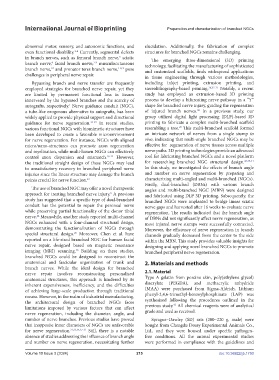Page 223 - IJB-10-3
P. 223
International Journal of Bioprinting Preparation and characterization of branched NGCs
abnormal motor, sensory, and autonomic functions, and elucidation. Additionally, the fabrication of complex
even functional disability. Currently, segmental defects structures for branched NGCs remains challenging.
1-4
in branch nerves, such as femoral branch nerve, sciatic The emerging three-dimensional (3D) printing
5
branch nerve, facial branch nerve, musculocutaneous technology, facilitating the manufacturing of sophisticated
7-9
6
branch nerve, and pronator teres branch nerve, 11,12 pose and customized scaffolds, finds widespread applications
10
challenges in peripheral nerve repair. in tissue engineering through various methodologies,
Bypassing branch and nerve transfer are frequently including inkjet printing, extrusion printing, and
employed strategies for branched nerve repair, yet they stereolithography-based printing. 26,32-37 Notably, a recent
are limited by permanent functional loss in tissues study has employed an extrusion-based 3D printing
innervated by the bypassed branches and the scarcity of process to develop a bifurcating nerve pathway in a “Y”
autografts, respectively. Nerve guidance conduit (NGC), shape for branched nerve injury, guiding the regeneration
1
a tube-like exogenous alternative to autografts, has been of injured branch nerves. In a previous study, our
38
widely applied to provide physical support and directional group utilized digital light processing (DLP)-based 3D
guidance for nerve regeneration. 13-15 In recent studies, printing to fabricate a complex multi-branched scaffold
25
various functional NGCs with biomimetic structures have resembling a tree. This multi-branched scaffold formed
been developed to create a favorable microenvironment an intricate network of nerves from a single stump in
for nerve regeneration. For instance, NGCs with aligned vivo, indicating that multi-angle branched NGCs may be
micro/nano-structures can promote axon regeneration effective for regeneration of nerve tissues across multiple
and myelination, while multi-lumen NGCs can effectively nerve paths. 3D printing technologies provide an advanced
control axon dispersion and mismatch. 16-22 However, tool for fabricating branched NGCs and a novel platform
the traditional straight design of these NGCs may lead for researching branched NGC structural design. 26,39-41
to unsatisfactory recovery in branched peripheral nerve In this study, we investigated the effects of branch angle
injuries since the linear structure may damage the branch and number on nerve regeneration by preparing and
points crucial for nerve function. 23 characterizing multi-angled and multi-branched (NGCs).
Firstly, dual-branched (DBNs) with various branch
The use of branched NGC may offer a novel therapeutic angles and multi-branched NGC (MBN) were designed
6
approach for treating branched nerve injury. A previous and fabricated using DLP 3D printing. Subsequently, the
study has suggested that a specific type of dual-branched branched NGCs were implanted to bridge linear sciatic
conduit has the potential to repair the peroneal nerve nerve gaps and harvested after 16 weeks to evaluate nerve
while preserving partial functionality of the donor tibial regeneration. The results indicated that the branch angle
nerve. Meanwhile, another study reported multi-channel of DBNs did not significantly affect nerve regeneration, as
24
NGCs enhanced with a four-channel structural design, most injured nerve stumps were successfully connected.
demonstrating the functionalization of NGCs through Moreover, the efficiency of nerve regeneration in branch
special structural design. Moreover, Chen et al. have channels gradually decreased from the center to the side
25
reported on a life-sized branched NGC for human facial within the MBN. This study provides valuable insights for
nerve repair, designed based on magnetic resonance designing and applying novel branched NGCs to promote
26
imaging (MRI) scanning. Building on these studies, branched peripheral nerve regeneration.
branched NGCs could be designed to reconstruct the
anatomical and fascicular organization of trunk and 2. Materials and methods
branch nerves. While the ideal design for branched
nerve repair involves reconstructing personalized 2.1. Material
anatomical structures, this approach is hindered by its Type A gelatin from porcine skin, poly(ethylene glycol)
inherent expensiveness, inefficiency, and the difficulties diacrylate (PEGDA), and methacrylic anhydride
of achieving large-scale production through traditional (MAA) were purchased from Sigma-Aldrich. Lithium
means. However, in the realm of industrial manufacturing, phenyl-2,4,6-trimethyl-benzoylphosphinate (LAP) was
the architectural design of branched NGCs faces synthesized following the procedures outlined in the
42
limitations imposed by various factors that can affect previous study. All chemical reagents were of analytical
nerve regeneration, including the diameter, angle, and grade and used as received.
number of nerve branches. Previous studies have proved Sprague–Dawley (SD) rats (200–220 g, male) were
that inapposite inner diameters of NGCs are unfavorable bought from Chengdu Dossy Experimental Animals Co.,
for nerve regeneration. 21,22,24,27-31 Still, there is a notable Ltd., and they were housed under specific pathogen-
absence of studies addressing the influence of branch angle free conditions. All the animal experimental studies
and number on nerve regeneration, necessitating further were performed in compliance with the guidelines and
Volume 10 Issue 3 (2024) 215 doi: 10.36922/ijb.1750

